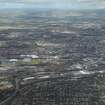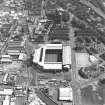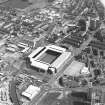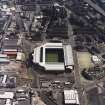Glasgow, 100-170 Edmiston Drive, Ibrox Stadium
Football Ground (19th Century), Stadium (20th Century)
Site Name Glasgow, 100-170 Edmiston Drive, Ibrox Stadium
Classification Football Ground (19th Century), Stadium (20th Century)
Alternative Name(s) Broomloan Road; Glasgow Rangers Football Club; Govan
Canmore ID 44256
Site Number NS56SE 121
NGR NS 55477 64578
NGR Description Positioned on Main Stand to Edmiston Drive
Datum OSGB36 - NGR
Permalink http://canmore.org.uk/site/44256
- Council Glasgow, City Of
- Parish Govan (City Of Glasgow)
- Former Region Strathclyde
- Former District City Of Glasgow
- Former County Lanarkshire
Ibrox Stadium, 100-170 Edmiston Drive, 1928, Archibald Leitch & Ptnrs
Tall Renaissance red brick stand to Edmiston Drive, with central entrance and end pavilions, for Rangers FC. Then the largest, most lavish stand ever built, with 10,000 seats. Extended, 1994, Gareth Hutcheson. Club and executive upper deck, with catering and private boxes, and lower front deck, supported on 141m (462ft) girder beam. Brick and glass block corner stairtowers.
Taken from "Greater Glasgow: An Illustrated Architectural Guide", by Sam Small, 2008. Published by the Rutland Press http://www.rias.org.uk
NS56SE 121 55477 64578
Ibrox Stadium
(Rangers F C) [NAT]
OS 1:1250 map, 1972.
The main stand is a listed building dating from 1928. The other three stands are between 10 and 15 years old, results of an investment in safety improvements following the East Stairway disaster.
Prospect, Summer 1995
Main stand reconstructed by Gareth Hutchinson Architects, Edinburgh, 1992. Involved creation of two upper decks seating 7,000 debenture holders, and 24 executive boxes each seating 20. External features include circular glass block end towers and a 141- metre clear span roof girder.
RIAS 1992.
Project (2007)
This project was undertaken to input site information listed in 'Civil engineering heritage: Scotland - Lowlands and Borders' by R Paxton and J Shipway, 2007.
Publication Account (2007)
Glasgow is well known throughout the football world for its three major stadia, all of which have been redeveloped in recent decades (Ibrox, Hampden and Celtic Park). The first to be so developed was at Ibrox for Rangers Football Club originally opened in 1899. The present stadium was commenced in 1978 after a disaster in 1971 when overcrowding on Stair 13 resulted in 66 deaths and 145 injuries. Only the south main stand of 1929 was retained, the other three sides of the ground were provided with new individual stands having open corners to assist wind flow on to the pitch.
The new Ibrox stadium was opened in 1981, play having continued uninterrupted during construction, and was an immediate success. All the new stands have an unusual structural arrangement in which the roof did not cantilever from the rear but was supported at the gable near to its front edge by a massive lattice girder spanning the full width of the seating and allowing column-free viewing. These girders span 256 ft at the east and west spans and 356 ft at the Govan stand. The slopes of the seating tiers range from 228 to 348. Later the main stand was developed in the same way with a girder spanning 476 ft which was at the time the largest clear span of its type in the world. This form of construction is relatively expensive and now rarely used in stadium design. The engineers for the new Ibrox Stadium were Thorburn Colquhoun.
R Paxton and S Shipway 2007
Reprouced from 'Civil Engineering heritage: Scotland - Lowlands and Borders' with kind permission of Thomas Telford Publishers.
Publication Account (2009)
Rangers FC moved to Ibrox Park in 1899, although the earliest of the present buildings is the south stand of 1927–29 by engineer Archibald Leitch (fig 5.56; Williamson et al 1990, 592).
Information from ‘The Scottish Burgh Survey, Historic Govan: Archaeology and Development’ (2009).

































































































































































